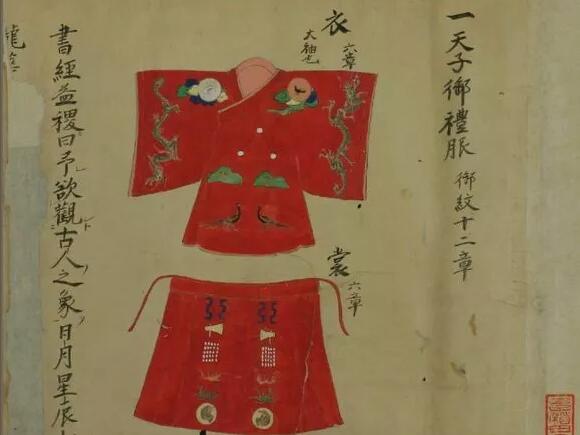唐朝服饰文化对诸多邻国都有广泛而又深刻的影响,比如日本和朝鲜等邻国。本文着重介绍唐朝服饰对邻国中的日本和朝鲜的影响。
Tang Dynasty clothing has a profound and extensive effect on numerous neighboring countries, such as Japan and North Korea. This article emphatically introduces the influence of Tang Dynasty clothing on Japan and North Korea.

唐朝某一时期的地图
A map of the Tang Dynasty
唐朝服饰
对日本的影响
一、唐朝服饰对日本的影响:
The influence of Tang Dynasty clothing on Japan:
日本的和服是根据我国唐朝服装改制的,因为是从我国江渐一带“移植”过去的,所以又称之为“吴服”。虽然后来日本人又对和服进行了一些改造,但依然保留着我国古代服装的特点。
The kimono was adapted from the costume of Tang Dynasty, which was also called “Wu Clothing”. Because it was “transplanted” from Jiangsu and Zhejiang provinces, China. Although afterwards the Japanese made some alterations on the kimono, it remains the characteristics of ancient Chinese clothing.

(一) 款式 Style
中国古代纺织技术发达,丝绸乃是当时江浙地区的代表性产物。据史书记载,日本天皇到中国去请专门技术人员教给日本养蚕丝织技术。日本最初的衣服面料以麻为主,所以随着纺织技术的发展,和服面料更加丰富,给和服款式的设计也提供了便利。
The silk was the representative product in Jiangsu and Zhejiang provinces, which reflects that the textile technique level was high in the ancient China. According to historical records,Japan’s emperor once went to China to invite the professionals to teach the Japanese how to rear silkworms and weave silk. Japanese original clothing material was linen. Consequently, with the development of the textile technology, the clothing material of kimono became more abundant, which provided convenience for the style design of kimono.
公元8世纪,中国正值盛唐时期(日本平安时代)。随着中日经济文化的交流,中国的唐装传入日本。日本天皇下诏宣布,全国不论男女老少穿衣服都要以唐朝的模式进行。“日本人的穿衣习惯由原来的左衽变为右衽[rèn],也是由这个时期开始的。”【1】日本大和民族曾专门制定法律规定制作衣服要仿照中国服装式样,决定制衣用冠都要仿照中国确定的着装制度。
In the eighth century, China was in the glorious age of Tang Dynasty while Japan was in Heian Period. In the communication process of economy and culture between China and Japan, the Tang clothing was introduced into Japan. The emperor of Japan declared in the imperial decree that human beings regardless of age and gender must dress in Tang style. Japanese dressing habit, which changed from left into right front piece, also began at this period. In addition, Yamato people even drafted the special law to regulate that making clothes should follow the Tang style and institution.

唐朝男士服饰
The men's clothing in Tang Dynasty
(二) 花纹与色彩 Pattern and color
日本和服的花纹与我国唐朝服饰花纹有着历史渊源。当时和服的名称,又叫“唐草“唐花“唐锦,足以见其紧密的联系。日本古代的服装很单调。随着中日文化的交流, 中国的服饰文化传到日本,给日本服饰注入了新的活力。“和服上有些图案,明显受到中国传统思想影响,如平安时代天皇的冕服,上衣绘有日月星辰,龙凤虎猿,御裤上半黑色的花纹,是受《礼记》的影响;有些图案,是在中国图案的基础上加工而成,如云鹤、波涛、菱、铜和蔓草等图案,多在我国唐朝传入日本,平安时代的艺人在此基础上予以加工而成”【2】。
The pattern of the kimono has a historical origin with the pattern of Tang Dynasty clothing. At that time, kimono was also named “Tang grass”, “Tang flower” and “Tang brocade”, which indeed indicates the close connection between the pattern of the kimono and the pattern of Tang Dynasty clothing. The ancient Japanese clothing was monotonous. But with the cultural communication between the two countries, the clothing culture of Tang Dynasty infused new energy to culture of Japanese clothing. Therefore, there are some patterns on the kimono that are obviously influenced by traditional Chinese thought. Myeonbok of Japan's emperor in Heian Period is a good example, which is influenced by Book of Rites. The craftsmen in Heian Period processed some patterns based on Chinese patterns, such as crane, wave, water chestnut, copper and creeping weed.

日本天皇冕服
Myeonbok of Japan's emperor
(三) 配饰 Accessories
日本和服的配饰中,很多都有唐朝的影子。以鞋袜为例,日本的《大宝律令》中,除了对服装款式做了明确的规定,鞋子也有明确的规定。不同阶层的人穿不同款式的鞋子,反映了森严的等级制度。“和服发展到后来鞋袜有了固定的模式。鞋子为木屐,袜子为分指袜。其实木屐在
中国有着悠久的历史,在文献资料中有很多地方做过描述。”【3】古乐府诗(唐以前的乐府诗)中有“黄桑柘屐蒲子履,中央有丝两头细”,很好的对木屐做了诠释。
The accessories of the kimono have a lot characteristics in common with Tang Dynasty clothing. Take shoes and socks as an example, in addition to making clear regulations on clothing styles, there are also clear regulations on shoes in Taiho code (the basic code of ancient Japan). People of different classes wear different styles of shoes, which reflects the rigid hierarchy. With the development of the kimono, shoes and socks have their fixed patterns, shoes are getas and socks are split. However, geta has a long history in China with numerous descriptions in literature. For example, ancient Yuefu poems (poems of the dynasties before Tang Dynasty) have made excellent explanatory notes.

日本木屐
Japanese getas
总之, 唐朝时期,唐朝服饰文化对日本产生了深远的影响,深刻地影响了日本民族服饰文化的产生与发展。
In a word, the costume culture of Tang Dynasty had a profound influence on Japan, and deeply affected the emergence and development of Japanese national costume culture.
唐朝服饰
对朝鲜的影响
二、唐朝服饰对朝鲜的影响:
The influence of Tang Dynasty clothing on North Korea:
朝鲜服也从形式上承继了唐服的长处。唐装襦裙线条柔长,十分优美自如,用料主要是丝织品,因此它的衣物以"软"和"飘柔"著称。
Korean clothing also formally inherited the advantages of Tang clothing. Served Ru(Tang clothing) have long soft lines and are very graceful and free, which are mainly made from silk. Therefore, its clothing is famous for softy.

朝鲜服 Korean clothing
直到今日,在中国东邻地区的一些国家,如日本、朝鲜等地,仍保留着中国传统的服制。
Until today, some countries in China's eastern neighborhood, such as Japan and Korea, still maintain the traditional Chinese clothing system.
- 下一篇: 唐朝服饰真的奔放吗
- 上一篇: 美轮美奂的唐代服饰图案



